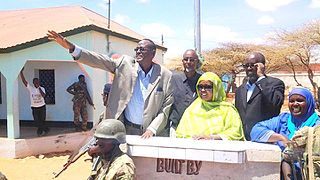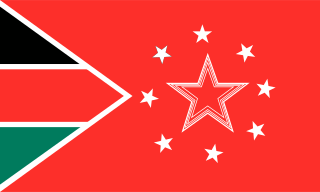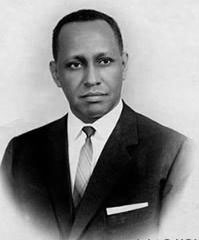Related Research Articles
The Eidagalle, is a major Somali clan of the Isaaq clan family. Members of this clan are concentrated in Somaliland and the Somali region of Ethiopia. The Eidagalle are part of the four principal clans of the Isaaq clan family. They are the traditional holders of the Isaaq Sultanate since the 18th century. As descendants of Ismail bin Sheikh Isaaq, its members form a part of the Habar Magaadle confederation, and they constitute the largest sub-clan of the Isaaq. They are traditionally nomadic pastoralists, merchants and skilled poets.

The Isaaq is a major Somali clan family. It is one of the largest Somali clan families in the Horn of Africa, with a large and densely populated traditional territory.

The Leelkase or Lailkase or Lelkase is a major subclan of the Tanade Darod clan. The term "Leelkase" is a nickname, which translates as "farsighted, mindful, smart or intelligent”

The Hawiye is the largest Somali clan family. Members of this clan traditionally inhabit central and southern Somalia, Somaliland, Djibouti, Ethiopia and Kenya. They are also the majority in the capital city, Mogadishu.
The Garre are a prominent Somali clan that traces its lineage back to Samaale, who is believed to have originated from the Arabian Peninsula through Aqiil Abu Talib. The Garre clan is considered to be a sub-clan of the Digil-Rahanweyn clan family, which is part of the larger Rahanweyn clan. However, genealogically, they are descended from Gardheere Samaale. The Garre are also categorized as southern Hawiye as well.
The Dir is one of the largest and most prominent Somali clans in the Horn of Africa. They are also considered to be the oldest Somali stock to have inhabited the region. Its members inhabit Djibouti, Somalia, Ethiopia, and northeastern Kenya.

The Marehan is a Somali clan, which is part of one of the largest Somali clan families, the Darod.

The Rahanweyn, also known as the Digil and Mirifle are a major Somali clan. It is one of the major Somali clans in the Horn of Africa, with a large territory in the densely populated fertile valleys of the Jubba and Shebelle rivers and the areas inbetween which are mainly inhabited by settlers from the Digil and Mirifle lineages.

Mandera is the capital of Mandera County in the former North Eastern Province of Kenya. It is situated at around 3°55′N41°50′E, near the borders with Somalia and Ethiopia.

Demographic features of Somalia's inhabitants include ethnicity, language, population density, education level, health, economic status, religious affiliations and other aspects of the population. Somalia is believed to be one of the most homogeneous countries in Africa.

Mandera County is one of the counties in Kenya. Its capital and largest town is Mandera. The county is bordered by Ethiopia to the north, Somalia to the east and Wajir County to the southwest. According to the 2019 census, the county has a population of 1,200,890 and an area of 25,939.8 square kilometres (10,015.4 sq mi). The main economic activity in the county is pastoralism, while others include cross-border trade with Ethiopia, artisanal mining, beekeeping, and agriculture along the Dawa River.

The Habar Gidir is a major subclan of the Hawiye. The clan has produced some prominent Somali figures, including the first Prime Minister of Somalia Abdullahi Issa Mohamud, and Somalia's fifth President Abdiqasim Salad Hassan.

The Mursade are a Somali subclan, part of the Karanle Clan, which is itself a part of the larger Hawiye Clan. They primarily reside in the central regions of Somalia, with a particular focus on the Galgaduud, Mudug, Middle Shabelle, Lower Shabelle and Banadir regions, among others. The Murusade clan were one the earliest inhabitants of Mogadishu, the capital city of Somalia. They hold a position of great significance and influence within Somalia. Their presence can be felt in various spheres of life in Mogadishu, attesting to their prominence and contribution to the socio-cultural fabric of the metropolis.
The Habr Awal, also contemporarily known as the Awal, and alternately known as the Zubeyr Awal is a major Northern Somali clan of the wider Isaaq clan family, and is further divided into eight sub-clans of whom the two largest and most prominent are the Issa Musa and Sa'ad Musa sub-clans. Its members form a part of the Habar Magadle confederation.

The Bimaal or Bimal, is a sub-clan of the major Dir clan family. This clan is widely known for leading a resistance against the colonials in southern Somalia for decades which can be compared to the war of the Sayyid in Somaliland. The Biimaal mainly lives in southern Somalia, the Somali region of Ethiopia, which their Gaadsen sub-clan mainly inhabits and in the NEP region of Kenya.
Rhamu, known to the locals as "shantooley", is a town in the Mandera County of Kenya situated in the northeastern part of Kenya, approximately 15 kilometers east of the River Dawa. The town lies within a semi-arid region characterized by dry and hot conditions, with limited rainfall and sparse vegetation. It is largely populated by the Garre and Murule Somali as well as a substantial settlement of Degodia clan on the north western side. The town was previously built by the british colonial administration and was the border between Quranyow-Banna section of the Garre tribe and Murule Rhamu is located at the international border between Kenya and Ethiopia. Due to its proximity to Ethiopia, Rhamu has historically been a center for cross-border trade. Local traders engage in the exchange of goods, including livestock, agricultural products, and other commodities with their Ethiopian counterparts.
The Gaalje'el, , or Habar Tigaalle is one of the largest Somali clans, whose origins trace back to Samaale. The Galje'el clan belong to the Major Saransor clans who is also sub clan of Wider Gardhere Samaale clans. The Clan is well known for their fierce battles against the Italian colonialists who were unable to occupy their land. This clan is also known for fighting against the Abyssinians for a long time who wanted to expand in the area of the Shabelle River, one of the biggest battles was the Battle of Dafet, at that time Abyssinians want to capture Dafet, entering from Shabelle River, but Gaalje'el fought back and defeated Abyssian and pushed them back; 1500 Amhara horsemen were killed in that battle.
The Gurgura, Gorgorah or Gurgure is a northern Somali clan, a sub-division of the Dir clan family.
The Sa'ad Musa or Saad Musa is a northern Somali clan. Its members form a part of the Habr Awal sub-clan of the Isaaq clan family. The Sa'ad Musa traditionally consists of nomadic pastoralists, coastal people, merchants and farmers. The clan inhabits Somaliland, including Maroodi Jeex, and Sahil as well as Djibouti, the Somali Region of Ethiopia, Kenya and Tanzania.
Shaaban Ali Isaack is a Kenyan politician. He hails from the Murule Clan of the Jidle Hawiye clan of the Somalis
References
- ↑ "Improved Conflict Management between the Murule and Marehan Clans in Mandera Triangle | IGAD Resilience". resilience.igad.int.
- ↑ Islam & Ethnicity in Northern Kenya & Southern Ethiopia. Boydell & Brewer. 2012. ISBN 9781847010469.
- ↑ "Murule clan's powerful leader whose word is final". Nation. October 13, 2020.
- ↑ "Mandera's Murulle clan inaugurate their Sultan in a colourful ceremony". The Star.
- ↑ Inter-clan Conflict in Mandera District: a Case of the Garre and Murulle, 2004-2009.
- ↑ "Kenya Alerts Camel Corps (1960)" – via www.youtube.com.